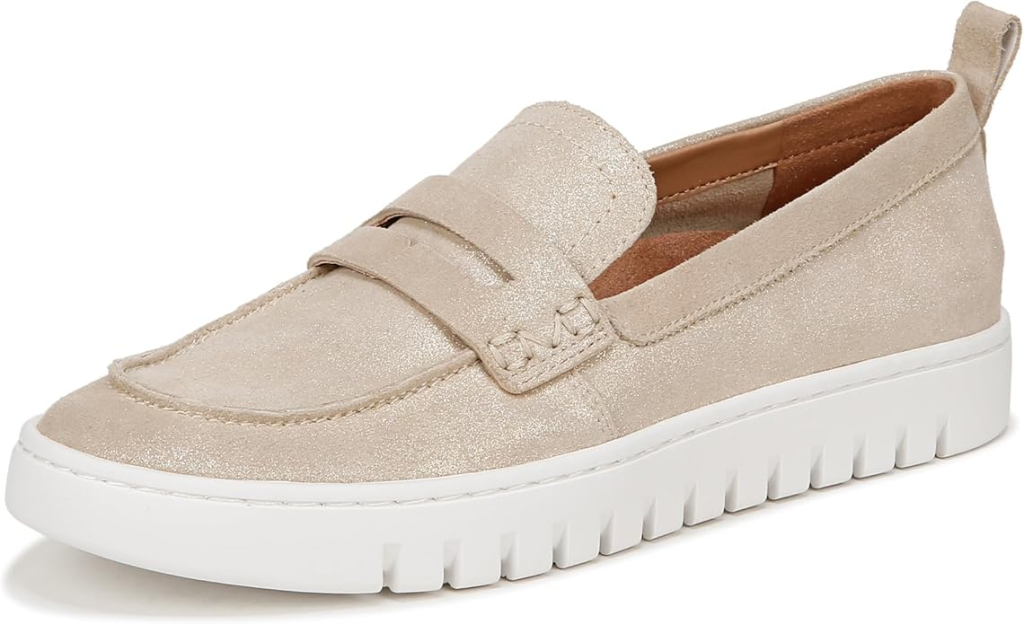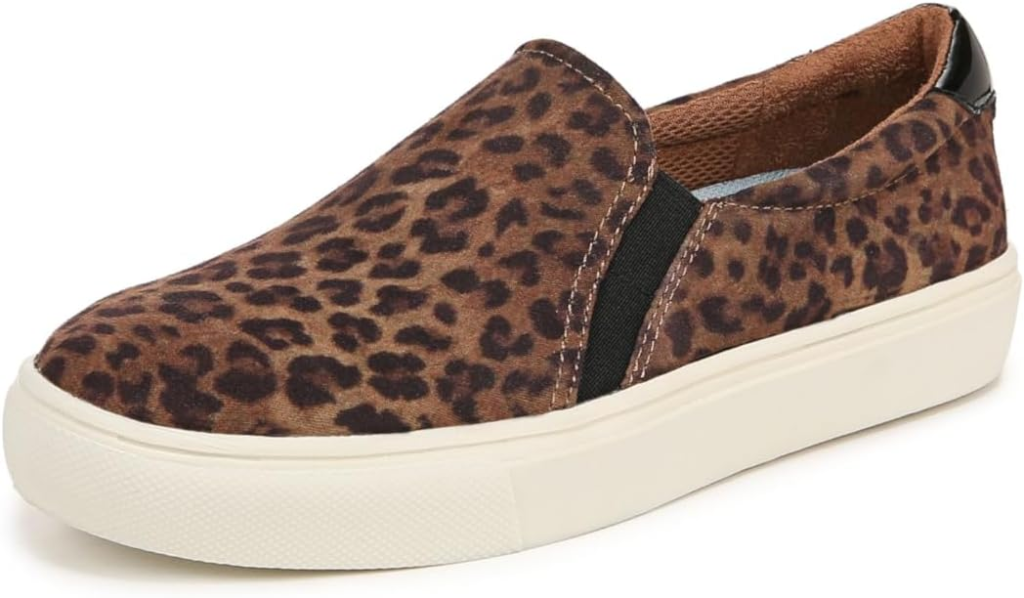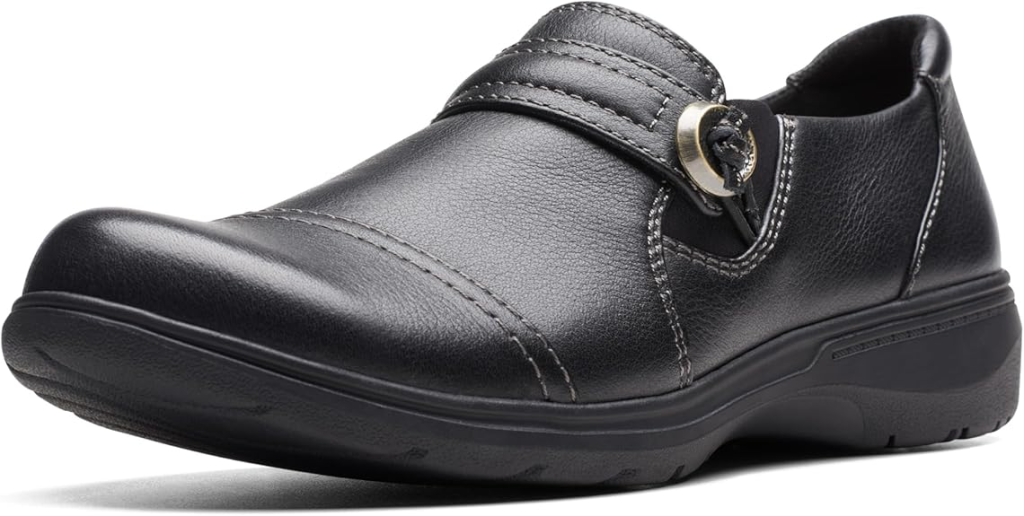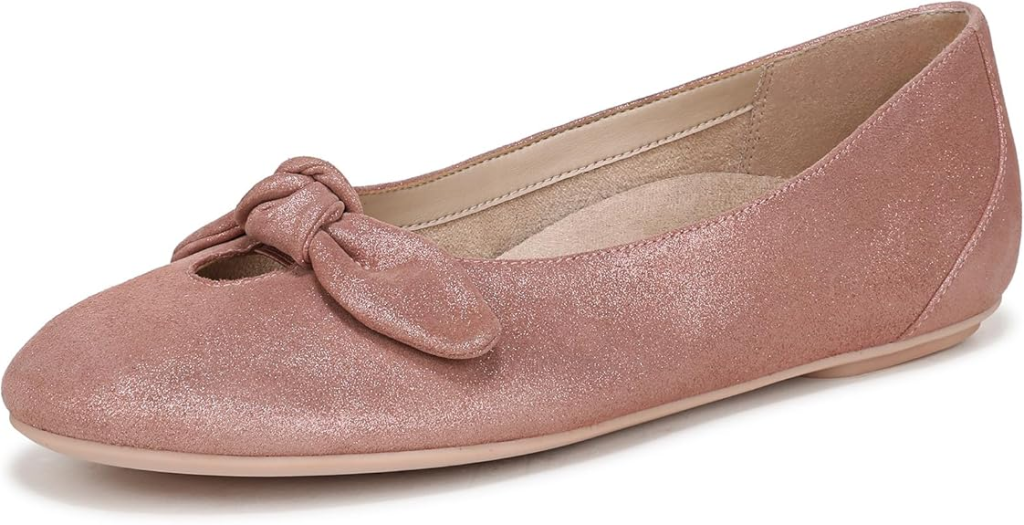Plantar fasciitis is one of the most common causes of heel pain in women, affecting professionals, teachers, healthcare workers, and anyone who spends extended hours on their feet. The condition results from inflammation of the plantar fascia, a thick band of tissue running along the bottom of your foot. Without proper support, the pain can be sharp, persistent, and disruptive to daily life—especially in formal or professional settings where dress shoes are required.
The good news? You no longer have to choose between comfort and style. Today’s market offers many fashionable, orthotic-friendly shoes designed to support the arch, cushion the heel, and alleviate foot fatigue. This guide will help you identify the best women’s dress shoes for plantar fasciitis, based on footbed design, arch support, heel stability, and style versatility.
🛍 Buying Guide: How to Choose the Best Women’s Dress Shoes for Plantar Fasciitis
1. ✅ Prioritize Arch Support and Heel Cushioning
Why it matters:
Arch collapse and heel pressure are the primary pain triggers for plantar fasciitis. Proper arch support keeps your foot aligned and distributes pressure evenly, while heel cushioning reduces shock impact.
Look for:
- Contoured arch footbeds
- Deep heel cups for alignment
- Memory foam, EVA, or gel cushioning
- Orthotic insole compatibility
Avoid:
- Completely flat insoles
- High heels without internal cushioning
2. 👣 Choose a Supportive, Stable Heel Height
Why it matters:
Contrary to popular belief, a completely flat shoe is not ideal for plantar fasciitis. A small, supportive heel helps relieve tension on the plantar fascia.
Recommended heel height:
- 1 to 2 inches: Reduces tension on heels and arches
- Block or wedge heels: Provide more stability and balance
- Low platform soles: Add height without heel pressure
Avoid:
- High, narrow stilettos or unsupported flats
3. 🧵 Select the Right Material and Construction
Why it matters:
Flexible yet supportive materials adjust to foot shape and prevent pressure points, while construction affects how well the shoe handles long hours of wear.
Ideal materials:
- Soft leather or vegan leather: Conforms to foot over time
- Breathable linings: Reduce sweating and friction
- Elastic goring or adjustable straps: Accommodate swelling or custom fit
Avoid:
- Hard plastic interiors
- Unpadded synthetic uppers
4. 🔒 Go for a Roomy Toe Box
Why it matters:
A narrow toe box can worsen foot strain by crowding the toes and shifting weight improperly. A rounded or almond-shaped toe box gives your forefoot room to move and prevents additional pain.
Look for:
- Medium to wide width options
- Soft uppers that stretch slightly
- Non-restrictive forefoot design
Avoid:
- Pointed toes or overly snug slip-ons
5. 🏃♀️ Focus on Shock Absorption and Flexibility
Why it matters:
Impact from walking can aggravate plantar fasciitis. A flexible sole with shock-absorbing properties can reduce heel strain.
Features to look for:
- Rubber or EVA midsoles for shock reduction
- Segmented soles that flex naturally with your foot
- Dual-density padding to cushion both heel and forefoot
Avoid:
- Hard soles with no flex
- Thin outsoles with poor impact resistance
6. 🧼 Consider Maintenance and Longevity
Why it matters:
Plantar fasciitis shoes tend to be an investment. Choosing a shoe that’s easy to maintain and built to last ensures value over time.
Look for:
- Durable soles and reinforced stitching
- Removable insoles (for cleaning or swapping with custom orthotics)
- Easy-to-clean uppers (leather or treated synthetics)
Avoid:
- Thin soles that wear quickly
- Shoes that lose cushioning after short use
7. 🎨 Don’t Compromise on Style
Why it matters:
Whether you work in an office, attend formal events, or just prefer polished looks, you deserve shoes that match your style and support your health.
Stylish yet supportive dress shoe types:
- Block heel pumps with padded insoles
- Orthotic-friendly loafers or oxfords
- Ballet flats with contoured footbeds
- Dress wedges with arch support
Go for neutral colors like black, taupe, or navy for workwear versatility—or try metallics and textures for special occasions.
📝 Final Buying Tips
When shopping for the best women’s dress shoes for plantar fasciitis, always try them on at the end of the day when your feet are most swollen. This helps ensure the shoes won’t feel too tight after long hours of wear. Also, walk around for several minutes to assess arch support and heel fit.
If you use custom orthotics, look for shoes with removable insoles and enough interior depth to accommodate them. Prioritize fit and foot mechanics over brand or style name—support and comfort are what relieve pain and help your feet recover.
With the right dress shoes, managing plantar fasciitis becomes easier—and looking good doesn’t have to come at the cost of comfort.
Here are six top-rated women’s dress shoes from Amazon that are especially supportive and suited for plantar fasciitis—each includes a detailed product description, key features, pros & cons, and a personalized recommendation:
1. Clarks Women’s Ashland Spin Q Slip-On Loafer

Product Description:
A sleek slide-on loafer with a modest heel (~1.3″), the Ashland Spin Q combines polished leather styling with an Ortholite footbed for structure and plush cushioning. The flexible outsole and Contour Soft padding help reduce fatigue during extended wear.
Key Features:
- Approximately 1.29″ supportive heel
- Ortholite footbed and cushioned insole
- Full-grain leather upper
- Flexible rubber outsole for traction
- Slip-on design with slight stretch
Pros:
- Immediately comfortable—minimal break-in required
- Excellent arch support and heel cushioning
- Smart, polished look for work or events
- Available in regular and wide widths
Cons:
- Narrow toe box may feel tight for some
- Leather requires occasional conditioning
Recommendation:
Ideal for anyone who needs a refined shoe with serious arch and heel support. Great for office wear or events where dressing up is required but plantar fasciitis needs to be managed.
2. Vionic Jacey Slip-On Wedge

Product Description:
A chic mid-height wedge (~2″) combining fashion and biomechanics. The Vionic Jacey features Vio-Motion orthotic support, deep heel cup, and a cushioned footbed—all built into a slip-on platform wedge.
Key Features:
- Built-in biomechanical orthotic footbed
- Deep heel cup and reinforced arch support
- Soft leather or synthetic upper
- Slip-on wedge silhouette with ankle-wrap design
Pros:
- Recognized support for plantar fasciitis relief
- Stylish wedge suitable for dress or business casual
- Extremely stable heel for posture and comfort
- Available in multiple colorways
Cons:
- Slightly higher heel may feel tiring after long hours
- Pricier than most basic flats or loafers
Recommendation:
Perfect for those seeking a stylish, dressy wedge that still offers functional support—great for workdays and events with standing or walking.
3. Dr. Scholl’s Women’s Insane Loafer

Product Description:
A memory-foam-goosed slip-on loafer in microfiber finished with a polished sheen. Lightweight and cushioned, it offers easy wearability for standing-heavy days.
Key Features:
- Microfiber upper for lightweight comfort
- Deep foam insole with shock absorbency
- Slip-on design
- Lightweight synthetic outsole
Pros:
- Comfortable immediately with plush cushioning
- Versatile look with dressy flavor
- Great for all-day wear when plantar fasciitis is a concern
Cons:
- Limited arch control vs. specialized orthotic brands
- Few color options available
Recommendation:
A stylish slip-on for smart-casual or business settings. Ideal if you want softness and ease without a heel, though orthotic inserts may improve support further.
4. Clarks Women’s Angie Pearl Loafer

Product Description:
A polished loafer with a modest block heel (~1.75″) and soft leather finish. Equipped with the brand’s Contour Soft technology and Ortholite footbed, the Angie Pearl blends elegance with orthopedic considerations.
Key Features:
- 1.75″ supportive heel
- Ortholite footbed with heel cushioning
- Leather upper with classic loafer styling
- Synthetic outsole with slight tread
Pros:
- Provides arch support and heel protection suitable for plantar fasciitis relief
- Very comfortable for extended wear
- Elegant enough for professional or formal outfits
Cons:
- May feel stiff initially before breaking in
- Sizing varies—try on for correct fit
Recommendation:
Ideal for those who want a polished, elevated loafer with built-in plantar fasciitis comfort. Great for office days or occasions requiring semi-formal styling.
5. LifeStride Women’s Parigi Pump

Product Description:
A rounded-toe pump with a moderate covered heel (~2.5″) featuring LifeStride’s “Soft System” insole cushioning system. This blend of wrap design and church pump silhouette keeps feet secure yet supported.
Key Features:
- Rounded toe box with cushioned interior
- Soft System padded insole with arch support
- Synthetic leather upper
- Covered block heel for stability
Pros:
- Comfortable silk-like linings enhance long-term wearability
- Stable heel height helps reduce plantar fascia tension
- Great for office, dinners, events
Cons:
- Heel height may not suit everyone
- Synthetic upper less breathable than leather
Recommendation:
Well-suited to those seeking elevated style with under-the-heel comfort. Stable enough for full-day standing and formal enough for dressed-up occasions.
6. Vionic Klara Ballet Flat

Product Description:
An elegant ballet flat built on Vionic’s podiatrist-designed orthotic footbed with deep heel cup and arch support, combined with a soft leather or knit upper. Lightweight and flexible for all-day wear.
Key Features:
- APMA-approved orthotic insole
- Deep heel cup and structured arch support
- Leather or knit upper options
- Flexible rubber outsole with slight tread
Pros:
- Excellent built-in plantar fasciitis support
- Slim, sleek profile for dress or smart casual outfits
- Breathable and flexible for pressure distribution
Cons:
- Not much elevation—may suit users who tolerate flats
- Can feel narrow if you have wide or swollen feet
Recommendation:
Best for users who need a flat style but still require structured arch + heel support. Great with skirts, slacks, or trousers for dress-friendly daily wear.
📝 Quick Selection Guide
| Shoe Model | Heel Height | Primary Support Feature | Ideal For |
|---|---|---|---|
| Clarks Ashland Spin Q | ~1.3″ | Ortholite cushioning & arch support | Refined loafers for all-day office wear |
| Vionic Jacey Wedge | ~2″ | Vio-Motion orthotic footbed | Dressy wedge with built-in support |
| Dr. Scholl’s Insane Loafer | Flat | Memory foam cushioning | Slip-on ease with plush comfort |
| Clarks Angie Pearl | ~1.75″ | Ortholite + Contour Soft insole | Elegant loafer for plantar relief |
| LifeStride Parigi Pump | ~2.5″ | Soft System arch and heel cushioning | Classic pump with functional support |
| Vionic Klara Ballet Flat | Flat | Podiatrist-designed orthotic footbed | Slim flat with structured plantar support |
✔️ Final Recommendations
- For maximum ergonomic support in a classy, versatile shoe, Clarks and Vionic options (Ashland Spin Q, Angie Pearl, Jacey, and Klara) are stellar.
- If you prefer a dress pump look but need support, the LifeStride Parigi delivers solid cushioning without compromising style.
- If you lean toward slip-on ease with everyday cushioning, Dr. Scholl’s Insane Loafer is a lightweight, practical option.
Here’s a complete guide on how to wash and care for women’s dress shoes for plantar fasciitis, including proper maintenance tips and precautions based on different materials like leather, synthetic, fabric, and orthotic features.
🧼 How to Wash Women’s Dress Shoes for Plantar Fasciitis
Proper care extends the life of your supportive shoes and helps maintain their structure, cushioning, and orthotic benefits—especially important for those managing plantar fasciitis.
1. 👠 Leather Dress Shoes (e.g., Vionic Jacey, Clarks Angie Pearl)
How to Clean:
- Use a soft, damp cloth to gently remove surface dust and dirt.
- For deeper cleaning, apply a leather cleaner or saddle soap using a microfiber cloth.
- Follow up with a leather conditioner to maintain softness and prevent cracking.
- Let the shoes air dry at room temperature, away from heat or sunlight.
Cautions:
- Never submerge leather shoes in water.
- Avoid harsh chemicals or alcohol-based cleaners.
- Do not dry with direct heat (like a hairdryer), as this can warp the leather and dry out the soles.
- Always test cleaning products on a small, hidden area first.
2. 🥿 Synthetic or Faux Leather Shoes (e.g., LifeStride Parigi, Dr. Scholl’s Insane Loafer)
How to Clean:
- Wipe down the surface using a damp cloth and mild soap.
- For scuffs or deeper stains, use a soft-bristled brush or toothbrush.
- Rinse the cloth, then wipe off any soap residue.
- Pat dry and let air dry completely.
Cautions:
- Don’t scrub too aggressively—synthetic materials can peel or crack.
- Avoid oil-based cleaners, which may discolor faux leather.
- Do not machine wash or soak.
3. 🩰 Fabric or Knit Dress Shoes (e.g., Vionic Klara Ballet Flat)
How to Clean:
- Most knit or fabric shoes are spot-clean only.
- Use a mild detergent mixed with water and a soft cloth or brush.
- Gently scrub the dirty areas, then blot dry with a clean towel.
- Let the shoes air dry naturally, away from direct sun or heaters.
Cautions:
- Do not use bleach or harsh chemicals—these can break down fabric fibers.
- Avoid machine washing unless the brand explicitly says it’s safe.
- Stuff shoes with paper towels while drying to maintain shape.
4. 🧽 Insoles and Footbeds
How to Clean:
- Removable insoles can be hand washed with mild soap and warm water.
- Rinse thoroughly and air dry completely before reinserting.
- For non-removable footbeds, use a cloth dampened with diluted vinegar or baking soda paste to freshen and clean.
Cautions:
- Never machine wash orthotic insoles unless labeled washable.
- Avoid over-wetting the inside of the shoe, which can degrade adhesive and padding.
5. 🔄 Regular Maintenance Tips
| Maintenance Task | Frequency | Purpose |
|---|---|---|
| Surface Wipe | Weekly/as needed | Remove dirt, dust, and preserve appearance |
| Conditioning (Leather) | Monthly | Maintain softness and prevent cracking |
| Insole Cleaning | Biweekly | Eliminate odor and bacteria buildup |
| Waterproofing Spray | Every 2–3 months | Protect against water and stains |
⚠️ Key Cautions When Washing Dress Shoes for Plantar Fasciitis
- Avoid soaking any shoe entirely—moisture can ruin structural integrity and reduce support, especially around arch and heel areas.
- Always allow shoes to dry completely before the next use to prevent mold, mildew, or material warping.
- Do not expose shoes to direct heat sources—this can shrink or deform padding and footbeds.
- Store shoes with care—use shoe trees or paper to maintain shape, especially in leather models.
❓ Frequently Asked Questions (FAQs)
Q1: Can I wear dress shoes daily if I have plantar fasciitis?
Yes—if the dress shoes are designed with proper arch support, heel cushioning, and shock absorption. Look for shoes specifically made to relieve plantar fasciitis symptoms, such as those with contoured footbeds, deep heel cups, and orthotic-compatible insoles.
Q2: What heel height is best for plantar fasciitis dress shoes?
A low to moderate heel height (1 to 2 inches) is generally best. Completely flat shoes can strain the arch and heel, while very high heels can misalign posture and increase pressure. Block heels or wedges are ideal for balance and comfort.
Q3: Do I need custom orthotics, or are built-in footbeds enough?
Some built-in footbeds from brands like Vionic or Clarks are sufficient for mild to moderate plantar fasciitis. However, if your pain is chronic or severe, custom orthotics may offer better results—look for shoes with removable insoles so you can insert your own.
Q4: Are flats okay for plantar fasciitis?
Flats are fine only if they have built-in support, such as arch support, heel padding, and a slightly elevated heel. Most fashion flats lack these features, but brands like Vionic and Naturalizer offer supportive flat styles suitable for plantar fasciitis.
Q5: How long will supportive dress shoes last if I wear them daily?
With daily wear and proper care, high-quality supportive dress shoes can last 6 to 12 months. Regularly cleaning, rotating pairs, and replacing worn-out insoles can extend their lifespan even further.
Q6: Are wide-width options necessary?
If you have wider feet or experience toe crowding, choosing wide-width shoes is important. A roomy toe box prevents pressure on the forefoot and allows for proper weight distribution—key factors in managing plantar fasciitis.
Q7: How can I tell if a shoe will aggravate my plantar fasciitis?
Avoid shoes that are:
- Completely flat (no arch support)
- Too flexible or floppy
- Lacking heel cushioning
- Tight in the toe or heel area
If the shoe lacks structure, support, or cushioning, it can worsen heel and arch pain over time.
✅ Conclusion
Finding the best women’s dress shoes for plantar fasciitis doesn’t mean sacrificing your style. With modern footwear technology, brands have blended orthopedic-level support with fashion-forward designs. Whether you’re looking for elegant pumps, professional loafers, or comfortable flats, there are supportive options that align with your lifestyle and wardrobe.
The key is to prioritize:
- Arch support
- Heel cushioning
- Shock absorption
- Stable heel height
- Proper fit and width
From workdays and formal events to everyday errands, the right dress shoe can help minimize heel pain, improve posture, and support foot recovery—without compromising your appearance.

